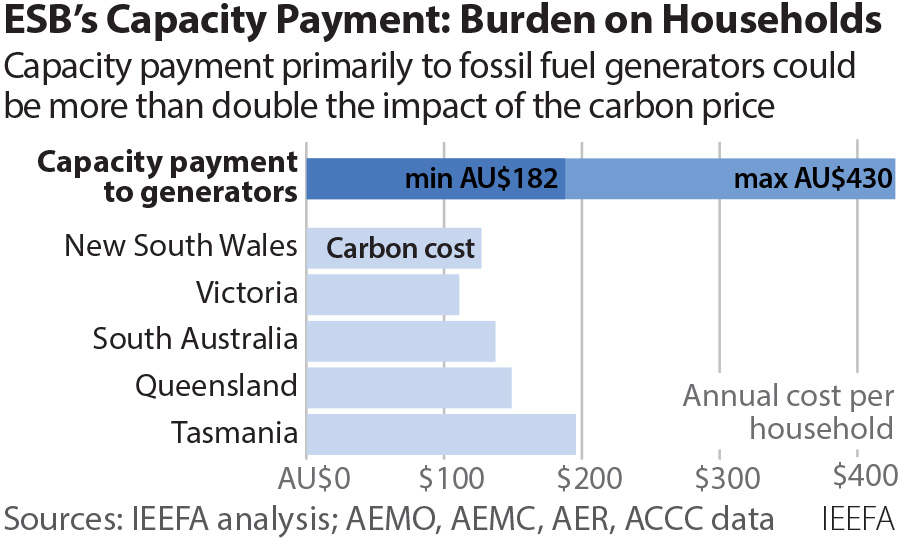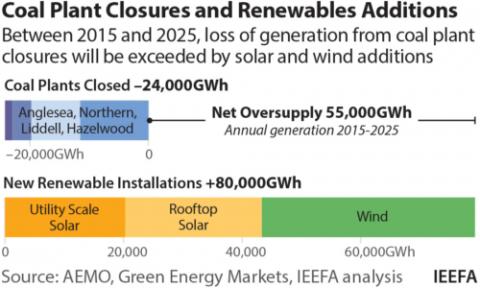IEEFA: Hit to power bills in Australia from coal bail-out plan

Key Takeaways:
Households may soon face a new charge on their power bills – potentially double that from the carbon price – if Energy Ministers agree to a proposal for a new capacity payment to power companies.
Our analysis finds that reliability is not at threat by the level of likely coal power plant exits over the next ten years.
All states across the national electricity market have enough power capacity for the next decade to meet the strict reliability standard of satisfying more than 99.998% of demand.
20 August 2021 (IEEFA Australia): Households may soon face a new charge on their power bills – potentially double that from the carbon price – if Energy Ministers agree to a proposal for a new capacity payment to power companies, according to a new report prepared by the Institute for Energy Economics and Financial Analysis (IEEFA) and Green Energy Markets analysing the cost and reliability aspects of this capacity payment recommendation.
Households may soon face a new charge on their power bills
The Energy Security Board (ESB), with the backing of Australia’s Federal Energy Minister, wants electricity consumers in the national electricity market (the “NEM”) to start paying capacity payments to generators.
Johanna Bowyer, report co-author and IEEFA electricity analyst says under the scheme, electricity consumers would pay power plants not just for the electricity they actually generate, but also for the size of capacity installed in the power plant, irrespective of how often it might be needed.
“The ESB’s new proposal will require electricity consumers to pay primarily conventional generators such as coal and gas plants for what they could produce if the plant was operating at its full level of capacity, regardless of whether or not, or how often, the generator uses all of its capacity to produce electricity,” says Bowyer.
According to the ESB and Federal Energy Minister Angus Taylor, this new payment is necessary because many coal-fired power stations are becoming financially unviable and if they were to exit suddenly, it could lead to blackouts.
Our analysis finds that reliability is not at threat by the level of likely coal power plant exits
“While it is true that several coal power plants are facing financial difficulties, our analysis finds that reliability is not at threat by the level of likely coal power plant exits over the next ten years,” says Bowyer.
“Thanks in part to actions of the Federal Government, there is a flood of dispatchable capacity entering the NEM. This covers a range of controllable sources of power from hydro to batteries, bioenergy, gas and even some small coal power plant upgrades.”
Report co-author, Tristan Edis of Green Energy Markets says the grid is in a very different situation to when Hazelwood was shut down in 2017.
“From 2017 to 2027, almost 6,500 megawatts of dispatchable power project capacity will be added to the grid,” says Edis.
“To put this into perspective, this is almost double the capacity that will be lost from the next three coal power stations due to close after 2027 – Yallourn, Callide B and Vales Point B.
“This means that all states across the NEM have enough power capacity for the next decade to meet the strict reliability standard of satisfying more than 99.998% of demand.
All states across the NEM have enough power capacity for the next decade
“There are also thousands of megawatts of further battery projects in development which could be committed to construction if required.
“Meanwhile, the extra cost imposed on consumers to keep coal power plants afloat could be very large.”
IEEFA found that based on the range of capacity market prices seen in the Western Australian electricity market, consumers in the NEM would face a cost of between $2.9 billion to $6.9 billion each and every year if the capacity payment goes through.
Bowyer says the cost for households would be substantial.
“We found households in the NEM would see their electricity bills increase anywhere between $182 to $430 a year,” says Bowyer.
“By way of comparison, the cost increase faced by New South Wales, Victorian and Queensland consumers from the carbon price was between $112 to $150.
“Based on the Western Australian capacity payment experience, consumers could be facing a new charge which is potentially more than double that of the carbon price.
“Even at the lower end of capacity prices paid in the West Australian market, the cost on power bills would still be 21% greater than the carbon cost faced by Queenslanders, 30% higher for South Australians, 41% greater for New South Wales households, and 62% higher for Victorians.”
Media contact: Kate Finlayson ([email protected]) +61 418 254 237
Author contact: Johanna Bowyer ([email protected]) and Tristan Edis ([email protected])
About IEEFA: The Institute for Energy Economics and Financial Analysis (IEEFA) examines issues related to energy markets, trends, and policies. The Institute’s mission is to accelerate the transition to a diverse, sustainable and profitable energy economy. (www.ieefa.org)
About Green Energy Markets: Assists the Australian community in understanding the role and contribution of renewable energy to meeting our energy needs while also providing an important source of employment and reducing pollution. (www.greenmarkets.com.au)












